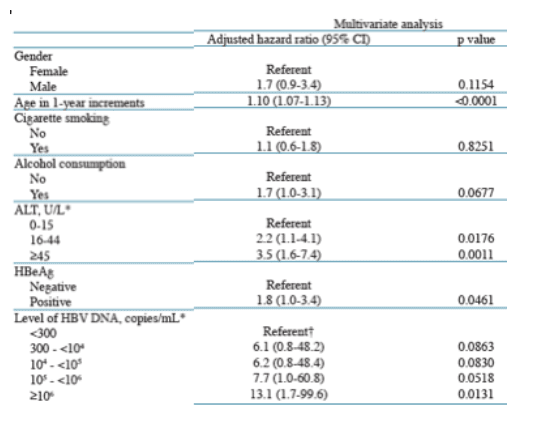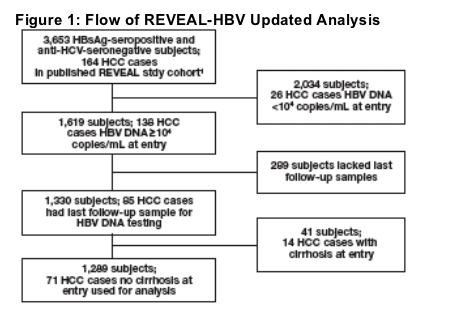 |
 |
 |
| |
Impact of chronically elevated HBV DNA viral load on risk of HCC occurrence: An update from The R.E.V.E.A.L.-HBV Study
|
| |
| |
Reported by Jules Levin
AASLD, Nov 2-6, 2007, Boston, MA
Chien-Jen Chen1,2, Hwai-I Yang1,2, Jun Su3, Chin-Lan Jen1,2, San-Lin You1,2, Chuen-Fei Chen1,2, Uchenna H Iloeje3 for The R.E.V.E.A.L.-HBV Study Group
1Genomics Research Center, Academia Sinica, Taipei, Taiwan; 2Graduate Institute of Epidemiology, College of Public Health, National Taiwan University, Taipei, Taiwan; 3Global Epidemiology and Outcomes Research, Research and Development, Bristol-Myers Squibb Co, Wallingford, CT, USA
Note from Jules: in table 3 below, HCC risk (adjusted hazard ratio) is 6.1 for 300 to 10,000 c/ml compared to reference group, <300 c/ml. HR is 6.2 for 10,000 to 100,000, HR is 7.7 for 100,000 to 1 million, and HR is 13.1 for >1 million.
Introduction
Published results from the R.E.V.E.A.L.-HBV study have demonstrated that baseline HBV DNA viral load level is the most important predictor of future risk of hepatocellular carcinoma (HCC).1,2
However in that publication, only levels of HBV DNA and alanine aminotransferase (ALT) at entry were used. The impact of chronically elevated HBV DNA over time on the risk of HCC accounting for changes in serum ALT level has not been evaluated.
Thus, this study aims to assess the HCC risk associated with long-term serum HBV DNA and ALT levels using time-dependent analyses. This report is an interim analysis.
Author Summary
Our previously published analyses were limited by the use of only baseline (one point in time) HBV DNA and serum ALT to predict the future risk of HCC development in chronic hepatitis B infected persons.
- This current analysis addresses that limitation and we have assessed HCC risk associated with multiple observations of serum HBV DNA and ALT levels over time. These are interim results from the subset of R.E.V.E.A.L. participants in whom we have completed HBV DNA analyses of all their frozen serum samples.
This subset of the R.E.V.E.A.L. study cohort had baseline HBV DNA ≥104 copies/mL, no evidence of liver cirrhosis at entry, anti-HCV negative and ≥2 frozen serum samples available for HBV DNA testing.
- Risk of developing HCC was strongly associated with increasing HBV DNA.
- Hazard ratio was 6.1 to 7.7 fold greater for individuals with HBV DNA of 300 - <104 copies/mL and was 13.1 fold greater for individuals with HBV DNA >106 copies/mL when compared with those who spontaneously achieved an undetectable HBV DNA level (<300 copies/mL).
- Repeatedly elevated serum ALT level was also an important predictor of HCC development.
Author Conclusion
These interim results confirm the fi ndings of our original analyses and demonstrate that serum HBV DNA level is likely the most important modifiable risk predictor of developing HCC. This finding is unchanged by the adjustment of HCC risk by chronic elevation of serum ALT, itself an independent predictor of HCC risk.
Table 3: Time-dependent Cox Regression Analysis of HCC Risk (N=1,289).
HCC risk (adjusted hazard ratio) is 6.1 for 300 to 10,000 c/ml compared to reference group, <300 c/ml. HR is 6.2 for 10,000 to 100,000, HR is 7.7 for 100,000 to 1 million, and HR is 13.1 for >1 million.

Methods
This analysis used a subset of the R.E.V.E.A.L.-HBV study cohort, which had HBV DNA ≥104 copies/mL and no evidence of liver cirrhosis at entry, anti-HCV negative and had 2 or more frozen serum samples available for HBV DNA testing (Figure 1).
Serum HBV DNA levels at study entry and last follow-up examination were measured using COBAS Amplicor HBV Monitor Test kit (Roche Diagnostics, Indianapolis, IN). Serum HBV DNA levels between first and last examinations were measured using COBAS TaqMan HBV Test kit (Roche Diagnostics).
As shown in the manufacturer's instructions, the results obtained with the COBAS TaqMan HBV Test and the COBAS Amplicor HBV Monitor Test were highly correlated (R2=0.977).

HCC cases were ascertained by computerized data linkage to the National Cancer Registry and Death Certifi cation System in Taiwan. All HCC cases were confirmed based on either:
- histopathology
- two positive coincident images technique
- one positive image technique with an elevated serum alpha-fetoprotein level >400 ng/mL.
Time-dependent Cox proportional hazard models were used to estimate multivariable adjusted hazards ratios (HRadj), where both HBV DNA and serum ALT were time dependent variables using multiple samples over the follow-up period. Serum ALT was categorized as 0-15, 16-44, and ≥45 U/L.

|
| |
|
 |
 |
|
|